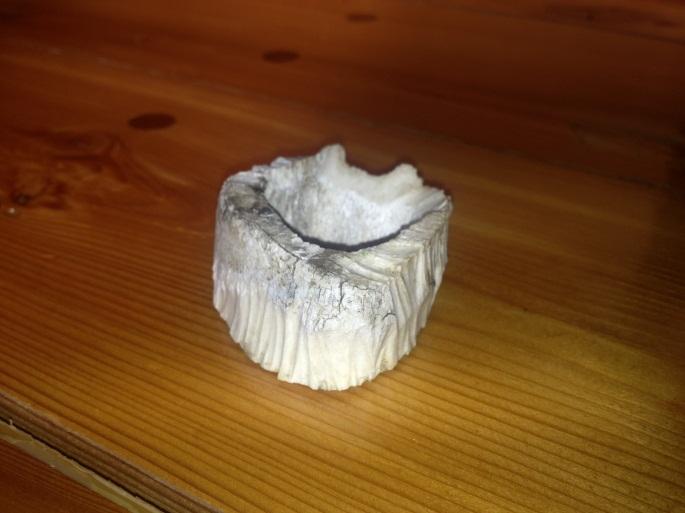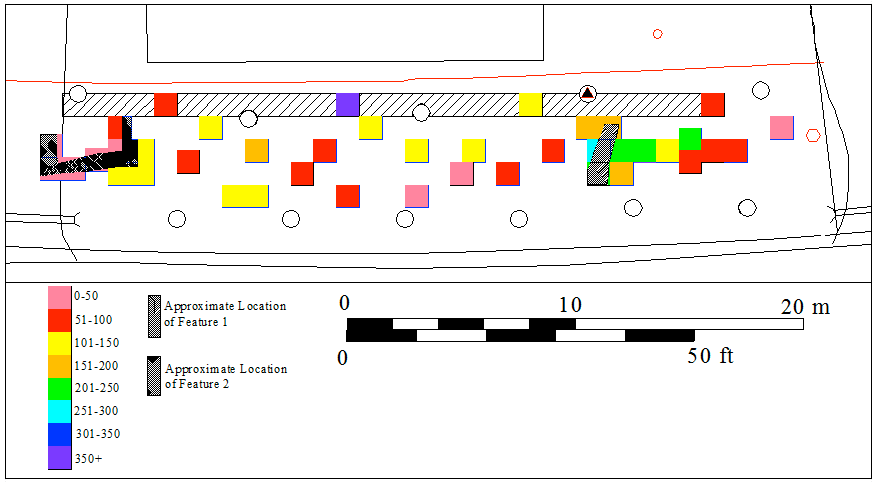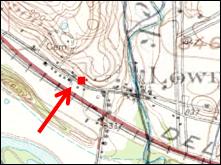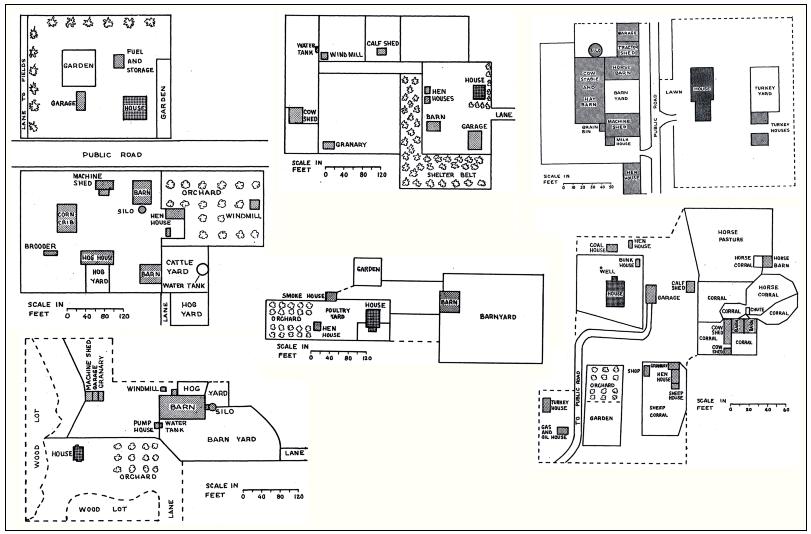Feature 1
The Feature 1 wall and organic midden complex was initially interpreted as part of a summer kitchen based on the limited archaeological sample gained during the Phase 2 site examination. However, the data recovery explorations of this part of the site showed that the wall was not part of an architectural structure like Feature 2. Faunal analysis, specifically the identification of rats and rat activity, proved to be the key to unlocking the mystery of Feature 1.
The rat (and unspecified rodent) assemblage was not large (n=17 in the yard and midden area), but the spatial organization of rat bones was informative. 3The presence of such animals in the sheet midden is not surprising, as the discarded food remains scattered across the yard would have naturally attracted scavengers. These food remains were densest east of the Feature 1 wall, with several units yielding over 100 bones apiece, and Unit 11 yielding as many as 220 bones. In contrast, the site average was 44 bones per unit. It is therefore surprising that this area of rich scavenging bounty east of the wall was devoid of rat/rodent bones, but Unit 17 (which lies due west of the wall outside this faunal rich zone) contained 86% (n=12) of the rat assemblage. Furthermore, the incidence of rodent-gnawed bones is very high in the yard deposits around Feature 1 (n=29, 85% of all rodent gnawed bones), but is very low (n=2, 6%) east of the wall. In other words, the area east of Feature 1 was particularly rich in faunal remains, and was apparently unavailable to scavenging rats. This suggests that Feature 1 may represent a section of wall from an enclosed space used for refuse disposal. Rats are certainly amenable to climbing in and out of an enclosed area, which suggests that this area may have been a pen housing animals whose presence discouraged adventurous rodents. Evidence of carnivore gnawing was observed on nine bones recovered from the area east of the wall. Another such bone was recovered from Unit 13, which contained Feature 1. No other units at the site contained carnivore gnawed bones, which supports the notion that Feature 1 was an animal pen.
Such a pen, with its sturdy stone walls and its dual use as a garbage location, was probably occupied by pigs. 4While these intelligent, self-sufficient animals could have been allowed to the freedom to forage for themselves on the yard midden and in the woods, they become harder to manage and can become nuisances. The pig skeletal remains showed that some pigs were allowed to live past their first year and may have grown to a substantial size. The male pigs might have become dangerous as their tusks grew in, and farrowing sows would have also presented a danger. A sturdy enclosure would have been necessary to keep the pigs under control, and a stone pen would have been ideal. Pigs are omnivorous, so it is likely that they were handy garbage disposers for the Baldwin Site household(s) who kept them. All sorts of kitchen scraps could be tossed into the pen, serving the dual purposes of feeding the hogs and lessening the yard refuse.

Feature 2
Despite extensive excavation to delineate the feature's walls and sample its interior contents, the purpose of Feature 2 remained enigmatic. Even if the artifact assemblage associated with the feature was derived from fill and the area around it did not yield an assemblage indicative of a particular activity, one might still expect the units associated with the demolished structure to yield a relatively high amount of architectural debris. However, in the case of Feature 2 the architectural material deposits are consistent with the remainder of the front yard, and there were larger quantities of architectural material closer to the front of the house and associated with Feature 1.
The limited quantities of architectural material associated with Feature 2 may be
a result of several factors. The first possibility relates to the type of construction
used in the superstructure. If the construction technique utilized a timber joined
method, then the demolition of the building would not yield significant architectural
artifact deposits. In most methods of timber joined construction (saddle notching,
V notching, diamond notching, full dovetailing, half dovetailing), there is little
or no need for nails.
A second possibility for the limited quantities of architectural material may relate
to demolition methods. It was common for building materials to be salvaged during
demolition for later reuse. If there was extensive salvaging of the Feature 2 superstructure,
then that might limit the amount of nails and glass deposited around the foundation.
A third possible explanation is that the Feature 2 superstructure was moved relatively intact, possibly during the construction of the Federal-style addition. The use of skids to drag away the building would have necessitated creating gaps in the foundation, and one such gap was evident. Furthermore, the foundation showed signs of outward scatter which is consistent with the dragging of a superstructure.
Unfortunately, no evidence of the superstructure for Feature 2 was recovered, and the archaeological evidence shows little differentiation between the surrounding deposits and the remainder of the yard. We can therefore only speculate on the various construction and destruction methods used for this small building and its purpose(s) within the farmstead.

Farmstead Layout
The discovery of an outbuilding and an animal pen sandwiched between the house and road was surprising to the archaeological team. In particular, the pen would have been noisy, smelly, and aesthetically unattractive in the narrow confines of a front yard. Consideration of the farmstead layout within the surrounding landscape offers an interesting avenue for discussion.
The house was built about 10 m (33 ft) from the base of a small hill. A composite quad map overlaying the 1902 and 1969 topography lines shows a significant change in the hill's elevation. The contours of the 1902 map represent 20 ft intervals, indicating a 60 ft rise behind the Baldwin Site house. On the 1969 map, each contour represents a 10 ft interval, with a rise behind the property totaling only 30 ft. The property owner informed the archaeological team that the top of the hill was stripped in the 1960s and used as fill for NY 17, which explains the mapping discrepancy.

The presence of a steep hill behind the house is significant, because it affected how the property was structured during its use as a rural farmstead in the late 18th and early 19th centuries. Some of the spatial composition of the Baldwin Site is related to this geographic constraint, and some may be related to the age of the site.
The Baldwin site represents a farmstead within an early frontier settlement. The original layout of the house lot included the small one and half story house, a small outbuilding located approximately 11 m (36 ft) west of the original house, and a stone wall likely marking the edge of an animal pen located 4 m (13 ft) southeast of the corner of the house. This layout created a multi-function area within the yard surrounding the front of the residence. Typical frontier farmstead houses were placed within cleared patches of woods to access sunlight and protection, and the Baldwin Site property had the added advantage of protection from a south facing hill and access all the way to the Chemung River.
However, this small house lot arrangement is not typical of what we generally find on rural farmsteads in upstate New York. To begin with, most 18th century farmsteads in the region do not include the original dwellings, but rather houses which date to the mid-19th century. Replacing log dwellings or small framed structures was a common trend in the mid-19th century as the wealth of farming families grew. At the same time, various publications appeared recommending "modern" farm layouts. Some of these new ideas may be seen at the Baldwin Site when the large Federal-style addition was built. Given the size and orientation of the addition, the Feature 2 outbuilding must have been removed or demolished prior to construction.
Generally, 19th century farmsteads had well defined spaces associated with the domestic structures, and spaces associated with the farm yard areas. Farm yards were commonly located behind or adjacent to the residential portion of the property; sometimes the farmyard areas were located across the street or at another off-site location. Examples of typical farmstead layouts show that houses tended to face the road with well-defined yard areas which were isolated from agricultural and animal husbandry zones, and indeed it is possible that the Baldwin Site farm also included barns and outbuildings across the street. However, the proximity of the house to the road and the spatial confinement created by the hill behind the house meant the early occupants of the Baldwin Site were forced to utilize the front yard for multiple property functions, including those typically associated with a barn yard rather than a house yard. Our excavations at the site reflect a variation in space utilization that is relatively unique when compared to front yard deposits at other upstate farmstead sites.
